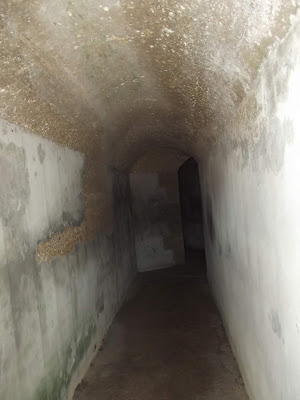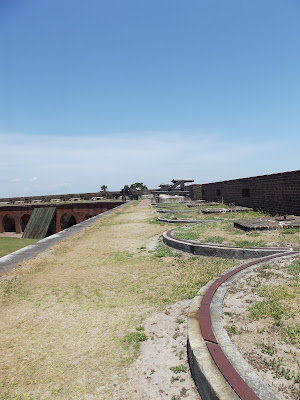The drive to Tybee Island, I love these trees with moss.
We stopped at the North Beach Bar and Grill for lunch. North Beach was incorporated in 1887.
Greg opted for a shrimp po’boy. We shared the sweet potato fries which was drizzled with a balsamic vinegar reduction, different but good.
The boardwalk to the beach.
The beach is crowded today, the last time we were here it was in the fall and rainy so we almost had the beach to ourselves. It was really hot out today so we didn’t stay long.
I still couldn’t convince Greg to climb to the top of the lighthouse.
We had to laugh because there is a sign that says the Battery Brumby is a “Severe Weather Safe Site” but all of the doors appear to be padlocked shut.
Greg wondered how long it would take a turtle to get across the road.
Ft. Pulaski is named for a Polish soldier who fought for Polish liberty against Russia. When Poland lost he was forced to flee his homeland. He met Benjamin Franklin in Paris in 1777 and Franklin inspired him to join America’s fight for freedom. In 1778 Congress selected him to command the newly formed cavalry unit and he became known as the “Father of the American Cavalry”. He was fatally wounded in 1779 during the Battle of Savannah.
Construction of the fort began in 1829, long before the War Between the States was to begin. Robert E. Lee, fresh out of West Point, took his first assignment as assistant engineer on the project. The marshy ground on Cockspur Island had to be prepared for the heavy fort. Lee conducted surveys, selected the exact site for the fort and began building the drainage and dike systems.
The view of the fort from the parking lot. This is a national memorial so our senior pass got us in for free.
Crossing the moat into the fort. The moat is 7’ deep and is home to the occasional alligator.
This is a passageway to the gun placements outside the fort. I was just glad there were no bats inside.
Massive doors were part of the defense of the fort.
The fort is built around this large grassy parade ground.
The breezes through these covered walkways was amazing on this very hot day.
Ten cisterns like this one stored 200,000 gallons of water. Rain water came in through a series of pipes. After the capture of the fort in 1862 Union soldiers supplemented the natural supply with a steam condenser which converted the moat’s salt water into fresh.
Col. Olmstead surrendered in this room on April 11, 1862.
Even though these cannons were built with a track so they could be moved, that had to be a major undertaking.
Thirty-one steep steps up a spiral stairway with no hand rail and you are on the top level.
Room for more cannons up here. The fort was designed for 140 cannons.
On April 10, 1862, Confederates refused a demand to surrender because the enemy guns were a mile away on Tybee Island – more than twice the range of heavy artillery of the day. However, the Union troops had new “rifled” cannons. When they fired those spinning projectiles, they bored through the brick walls of the fort especially those in the area containing 40,000# of gun powder. In less than 30 hours the Confederates were worried about being blown up by their own gun powder among other things. They considered the situation hopeless and surrendered.
Inside the fort from above.
Cannons could have lined the walls.
It took 25 million bricks to build the fort. Fingerprints of those who made the bricks can still be seen.
Confederate soldiers prepared for battle using earth and timbers to create a “bindage” to protect troops from incoming shells. They also dug ditches in the parade ground to catch rolling cannon shot (I thought this was genius).
The commanding officer’s quarters.
The Federal medical dispensary.
It was hard to get a picture of this bird, I think it is a brown pelican. Lots of these birds were diving into the water and catching fish for lunch. Quite the spectacle, but hard to catch on film, I need to get comfortable with videos.
More trees with moss on the way home.





























No comments:
Post a Comment